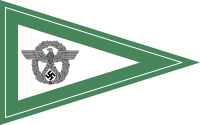Gemeindepolizei (Nazi Germany)

Gemeindepolizei (GemPo) is the German name for a municipal law enforcement agency. This article deals with the municipal police forces of Nazi Germany. Municipalities with more than 2,000 residents, not having a state police presence, had to have a municipal police department. The mayors were police commissioners. Under them the municipal police departments were led by professional chiefs of police. Towns with over 10,000 residents having a municipal police department were also obliged to have a municipal criminal investigation division.
Organization
[edit]Municipalities with more than 2,000 residents, not having a State protection police presence, had to have a municipal police department. In municipalities with less than 2,000 residents, the Gendarmerie was in charge of police protection. During the war, it was planned to extend the responsibility of the Gendarmerie to all towns with less than 5,000 residents, but it did not take place except to a very limited extent. In 1942 municipal police departments existed in 1,338 municipalities with more than 5,000 residents. Of these, five had more than 100,000 residents; 22 had 50–100,00, 591 had 10–50,000, and 720 had 5–10,000 residents.[1]
Municipal police departments
[edit]
In smaller towns, the Bürgermeister was police commissioner. He was subordinated to the Landrat as head of the Landkreis police administration. In a city that constituted its own Stadtkreis, the Oberbürgermeister was both police commissioner and head of the district police administration. As such he was subordinated to the Regierungspräsident in each Regierungsbezirk. Under the police commissioners the municipal police departments were led by professional chiefs of police.
| Size of the municipality | Police commissioner | Chief of police |
|---|---|---|
| 27 cities with over 50,000 residents | Oberbürgermeister | Stadtpolizeidirektor |
| 88 cities with 30–50,000 residents | Oberbürgermeister | Polizeioberinspektor |
| 106 cities with 20–30,000 residents | Oberbürgermeister | Polizeioberkommissar Polizeikommissar |
| 1,117 towns with 5–20,000 residents |
Bürgermeister | The nearest chief of the State protection police was also municipal chief of police. |
| Less than 5,000 residents | Bürgermeister | The nearest chief of the Gendarmerie was also municipal chief of police. |
Source:[2]
Protection Police
[edit]The municipal protection police in larger cities were called Kommando der Schutzpolizei, while it in smaller municipalities was called Schutzpolizei-Dienstabteilung.[1]
| Size of the municipality | Commander of the municipal protection police | Rank as |
|---|---|---|
| 27 cities with over 50,000 residents | Kommandeuer der Schutzpolizei | Oberstleutnant Major |
| 88 cities with 30–50,000 residents | Führer der Schutzpolizei-Dienstabteilung | Hauptmann |
| 106 cities with 20–30,000 residents | Führer der Schutzpolizei-Dienstabteilung | Inspektor / Revieroberleutnant |
| 1,117 towns with 5–20,000 residents |
Führer der Schutzpolizei-Dienstabteilung | Obermeister / Revierleutnant Meister |
Source:[2]
Kriminalpolizei
[edit]Towns with over 10,000 residents having a municipal police department were also obliged to have a municipal criminal investigation division—Gemeindekriminalpolizeiabteilung. It was supervised by the nearest State criminal investigation department (Kripo-Stelle). As of 1943 all municipal criminal investigation divisions with more than 10 detectives (i.e. mainly in cities with more than 50,000 residents) were transferred to the state Kriminalpolizei.[3]
Ranks in the municipal Kripo
[edit]| Rank in the municipal Kripo | Equivalent rank in the state Kripo | Relative rank as |
|---|---|---|
| Kriminalassistent | Kriminalassistent | Revieroberwachtmeister |
| Kriminaloberassistent | Kriminaloberassistent | Hauptwachtmeister |
| Kriminalsekretär | Kriminalsekretär | Meister |
| Kriminalbezirkssekretär | Kriminalobersekretär | Obermeister / Revierleutnant |
| Kriminalinspektor | Kriminalinspektor | Inspektor / Revieroberleutnant |
| Kriminaloberinspektor | Kriminalkommissar | Revierhauptmann |
Source:[4]
References
[edit]- ^ a b The German Police (Supreme Headquarters Allied Expeditionary Force: Evaluation and Dissemination Section (G-2), 1945), p. 24.
- ^ a b Phil Nix & George Jerome, The Uniformed Police Forces of the Third Reich 1933-1945 (Solna: Leandoer & Ekholm Förlag, 2006), p. 45.
- ^ The German Police (Supreme Headquarters Allied Expeditionary Force: Evaluation and Dissemination Section (G-2), 1945), p. 73–74.
- ^ The German Police (Supreme Headquarters Allied Expeditionary Force: Evaluation and Dissemination Section (G-2), 1945), p. 116–117.
